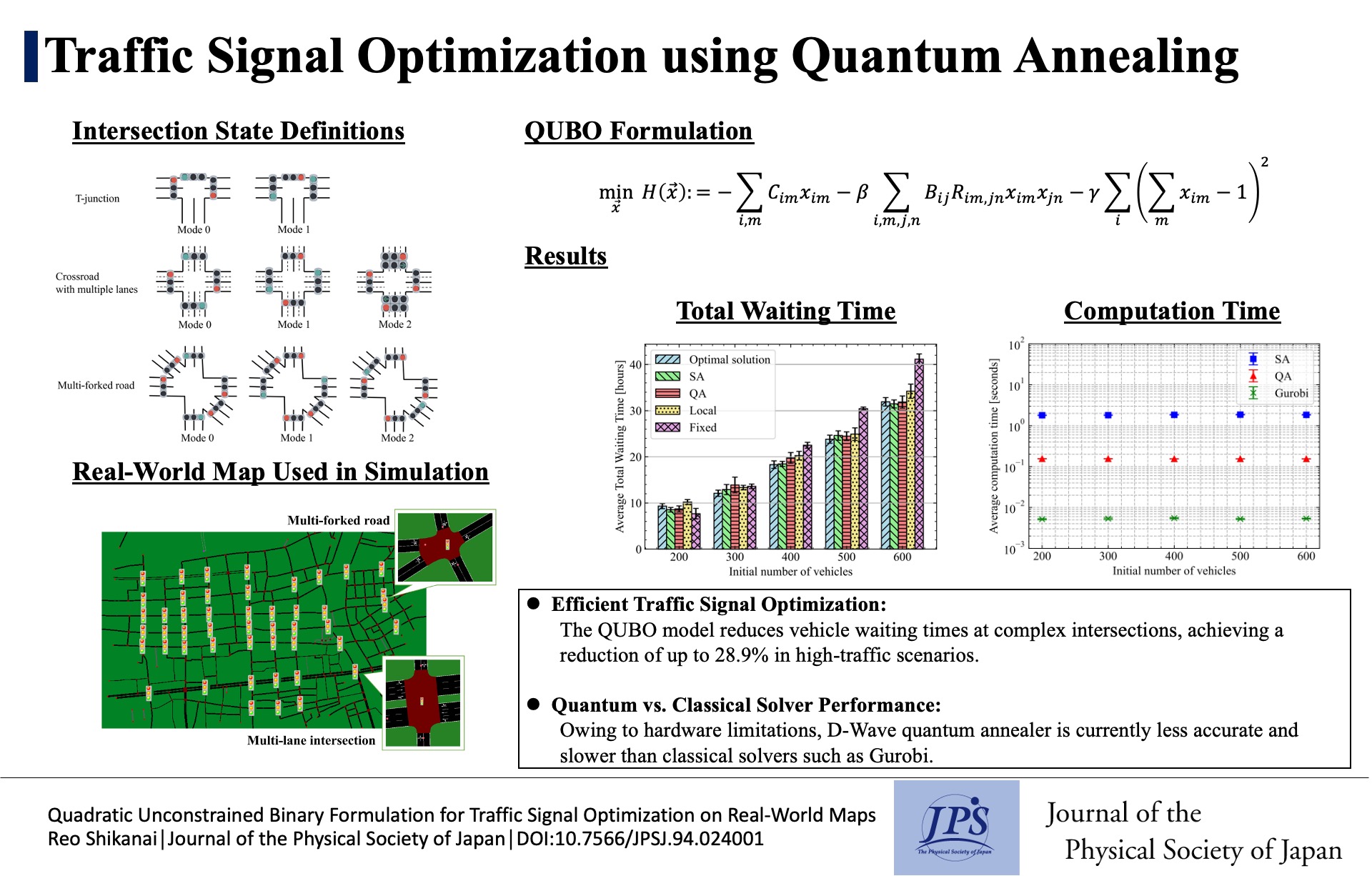Traffic Signal Optimization using Quantum Annealing
© The Physical Society of Japan
This article is on
Quadratic Unconstrained Binary Formulation for Traffic Signal Optimization on Real-World Maps
J. Phys. Soc. Jpn.
94,
024001
(2025)
.
This paper introduces a QUBO model for traffic signal optimization on real-world maps. Using D-Wave quantum annealing and SUMO simulations, the model reduces vehicle waiting times, but underperforms classical solvers.

Traffic congestion remains a challenge in urban environments, leading to increased travel time, fuel consumption, and environmental pollution. Traditional traffic signal control methods, such as fixed-cycle systems, fail to adapt to dynamic traffic conditions, causing inefficiencies. Recent advancements in quantum computing, particularly quantum annealing, have offered promising avenues for rapidly tackling complex optimization problems.
This paper presents an approach for traffic signal optimization using a quadratic unconstrained binary optimization (QUBO) framework. Previous studies focused on simplistic grid-like road layouts, whereas our model accommodates realistic urban scenarios, including T-junctions and multiforked intersections. We leverage the D-Wave quantum annealing machine to solve the QUBO and compare its performance with that of classical solvers, such as the Gurobi optimizer.
The proposed QUBO formulation aims to minimize vehicle waiting times at intersections. The cost function comprises three components: maximizing vehicle throughput, ensuring smooth traffic flow between adjacent intersections, and maintaining operational constraints. To validate the model, we used the simulation of urban mobility (SUMO) software, incorporating real-world geographical data from Aomori City, Japan.
Our simulations demonstrated that the QUBO model effectively reduced waiting times compared with traditional fixed-cycle controls, particularly under high traffic volumes. It achieved a reduction of approximately 28.9% in the total waiting time when compared with fixed-cycle methods in high-traffic scenarios (600 vehicles). However, the D-Wave quantum annealer struggled to consistently find optimal solutions and was slower than Gurobi. This performance gap is attributed to hardware limitations, such as the need for minor embedding and chain management in quantum processors.
However, the current hardware limitations of the D-Wave quantum annealer prevent it from outperforming classical solvers, such as Gurobi, in terms of solution quality and computational speed. The embedding process, which requires additional qubits and complex chain management, significantly affects performance. Moreover, internal parameters, such as annealing time and chain strength, were set to default values, suggesting that further tuning could enhance the effectiveness of the D-Wave machine. Additionally, reverse annealing and customized annealing schedules can potentially improve solution quality. Nevertheless, the adaptability of the QUBO model to real-world traffic conditions highlights its potential as the quantum hardware continues to evolve.
This study demonstrated the potential of QUBO-based traffic signal optimization in realistic urban settings. While the D-Wave quantum annealer currently underperforms classical solvers, the QUBO formulation proves to be a flexible and effective tool for reducing vehicle waiting times, achieving a reduction of up to 28.9% in high-traffic scenarios. Thus, with advancements in quantum hardware and further parameter tuning, quantum annealing can become a viable solution for real-time traffic management. Future studies should optimize the internal parameters, explore reverse annealing techniques, and extend the model to continuous-time domains for more responsive traffic control.
(Written by R. Shikanai on behalf of all the authors)
Quadratic Unconstrained Binary Formulation for Traffic Signal Optimization on Real-World Maps
J. Phys. Soc. Jpn.
94,
024001
(2025)
.
Share this topic
Fields
Related Articles
-
Higher-Order Topological Phases in Magnetic Materials with Breathing Pyrochlore Structures
Electronic structure and electrical properties of surfaces and nanostructures
Magnetic properties in condensed matter
Mathematical methods, classical and quantum physics, relativity, gravitation, numerical simulation, computational modeling
2025-4-7
A simple example of a higher-order topological phase, in which the symmetry decreases step-by-step from the bulk to the corner, is realized in a magnetic system with a pyrochlore structure and is characterized by a series of quantized Berry phases defined for the bulk, surface, and edge.
-
Exploring the Vibrant Interplay of Machine Learning and Physics
Cross-disciplinary physics and related areas of science and technology
Electron states in condensed matter
Elementary particles, fields, and strings
Mathematical methods, classical and quantum physics, relativity, gravitation, numerical simulation, computational modeling
Statistical physics and thermodynamics
Superconductivity
2025-3-13
This Journal of the Physical Society of Japan Special Topics edition explores how physics and machine learning complement each other and can solve unresolved problems in physics.
-
A Promising Solution to Nucleon–Nucleon Inverse Scattering Problem
General and Mathematical Physics
Mathematical methods, classical and quantum physics, relativity, gravitation, numerical simulation, computational modeling
Nuclear physics
2024-10-7
This study deals with the inverse elastic two-body quantum scattering problem using Volterra approximations and neural networks, offering a novel approach for solving complex nonlinear systems.
-
A New Method for Finding Bound States in the Continuum
General and Mathematical Physics
Mathematical methods, classical and quantum physics, relativity, gravitation, numerical simulation, computational modeling
Nuclear physics
2024-10-1
This study presents a general theory for constructing potentials supporting bound states in the continuum, offering a method for identifying such states in real quantum systems.
-
General Quasi-Joint Probabilities on Finite-State Quantum Systems
Mathematical methods, classical and quantum physics, relativity, gravitation, numerical simulation, computational modeling
2024-8-15
This study investigates the properties of general quasi-joint probability distributions in finite-state quantum systems, revealing the Kirkwood-Dirac distribution as among the most favorable. This highlights the importance of complex distributions in understanding quantum probability.




